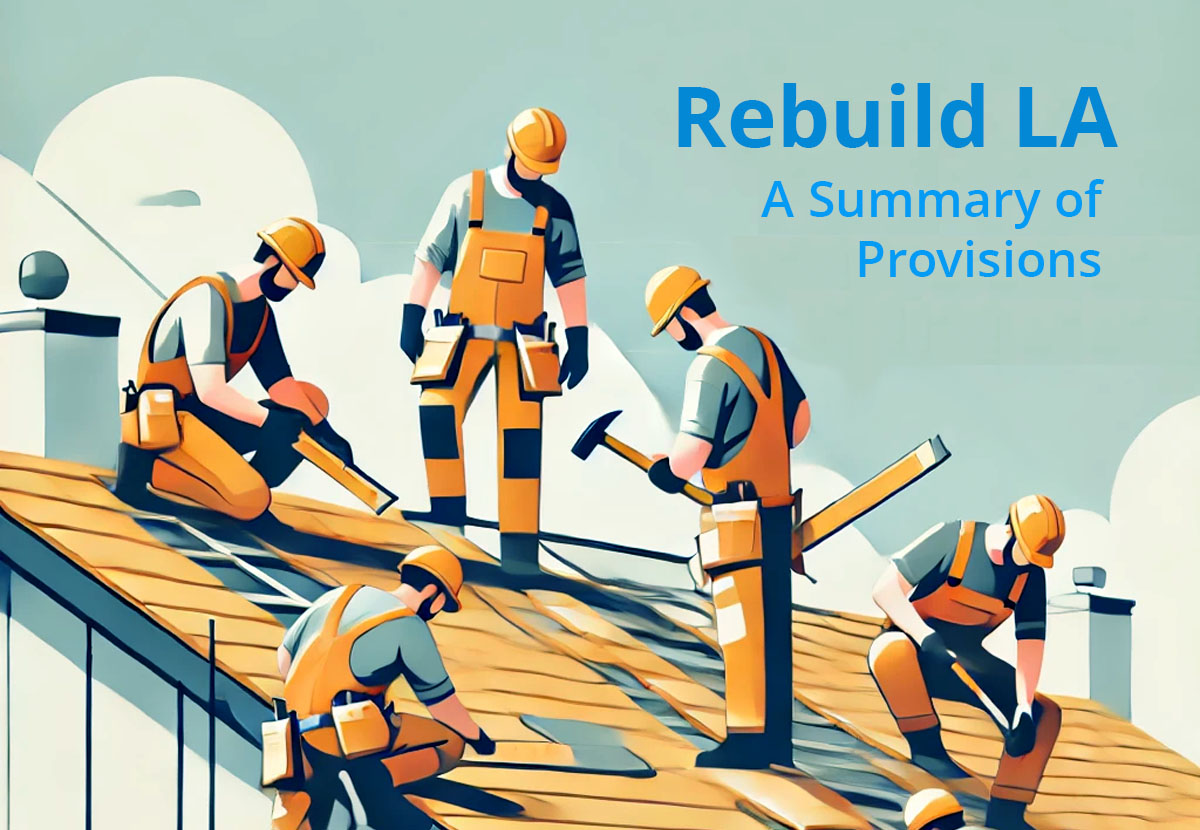Rebuild LA: A Summary of Provisions

Building Regulations Relaxed for LA Wildfire Recovery and Reconstruction in 2025
In early 2025, devastating wildfires swept through Los Angeles, destroying numerous homes and commercial buildings. As affected individuals begin considering reconstruction, many are unsure where to start or how to navigate the complex regulatory landscape. Architectural and building regulations can be difficult to understand due to their technical nature and scattered sources of information. To assist those impacted by the wildfires, we have compiled key information regarding regulatory relaxations for fire-damaged property reconstruction.
Key Building Regulation Changes for Fire-Affected Areas
To expedite recovery efforts, both LA County and LA City have implemented significant relaxations in building and environmental regulations:
Regulation Changes Common to Both LA City and LA County:
- Environmental Review Exemptions – Projects are exempt from environmental impact assessments under CEQA (California Environmental Quality Act) and the California Coastal Act.
LA City-Specific Changes:
- Disaster Recovery Permitting Center – A specialized permitting center has been established for expedited approvals.
- Reconstruction Timeline – Permits must be obtained within seven years, and construction must be completed within three years of approval.
- Gas Usage Exemptions – The requirement for all-electric buildings is temporarily lifted.
- Demolition Permit Exemption – Advance notice to the city allows for exemption from demolition permit requirements.
- Self-Certification for Architects – A program is in development to allow licensed architects to bypass standard permitting procedures for faster approvals.
LA County-Specific Changes:
- Identifying the Correct Governing Body – Reconstruction permits may be handled by LA County or the respective city government, making it essential to check the responsible authority. Information can be found on the LA County Disaster Recovery Website.
- Reconstruction Permit Timeline – Applications must be submitted within two years, with extensions of up to five years granted under special circumstances.
Important Considerations for Rebuilding
While these relaxed regulations provide significant relief, they only apply to like-for-like replacements—meaning that the new structure must closely match the original in location, size, and height. Expanding the building footprint or adding features such as Accessory Dwelling Units (ADUs) will disqualify the project from these exemptions.
To ensure compliance, property owners should gather accurate information on their original structure. This can be done using:
- LA City: LADBS Building Record Search System
- LA County: DPW Building Permit Viewer
However, official records may be incomplete. In such cases, alternative sources like aerial photographs, street view images, and personal property photos can serve as valuable documentation. Capturing online images before they are updated post-fire can also be useful.
Additional Precautions for Rebuilding
Aside from regulatory changes, homeowners should take the following steps to avoid financial and legal pitfalls during the rebuilding process:
1. Review Your Insurance Coverage
Check the maximum claimable amount with your insurance provider and prepare for potential additional costs beyond coverage limits.
2. Be Cautious of Fraudulent Contractors
After disasters, fraudulent contractors often take advantage of victims. The 2017 Tubbs Fire in Sonoma County saw multiple cases where contractors took upfront payments without completing construction. To avoid such scams:
- Verify contractor licenses on the California Contractors State License Board (CSLB).
- Research the contractor’s experience and reputation before signing any agreements.
Fire-Resilient Rebuilding Strategies
While regulatory relief helps expedite reconstruction, there are concerns about rebuilding fire-prone areas without improvements. Reconstructing buildings exactly as they were before may increase the risk of future disasters.
Government initiatives such as land acquisition for fire buffer zones are crucial, but individual homeowners can also take proactive steps, such as:
- Using fire-resistant materials – Instead of standard wood siding, consider fiber cement siding or concrete tile roofing for increased fire protection.
- Incorporating fire-resistant landscaping – Creating defensible space around the home by using non-combustible materials and fire-resistant plants.
By combining regulatory relief with thoughtful planning, homeowners can rebuild faster while enhancing fire resilience, ultimately creating safer communities for the future.
For professional guidance on navigating LA’s post-wildfire reconstruction process, feel free to reach out to PQNK INC. PQNK is a leading Korean-American architecture firm in Southern California specializing in multifamily residential, commercial, food & beverage, and healthcare design.
